"Let me treat you to an ice-cream," says Marty Morrissey, and we go to Doyle's Corner, a shop beside Semple Stadium. "You have to have an ice-cream from Doyle's. We'll get down to the serious business then."
The serious business is an interview which Marty is going to fit in around his four jobs: commentating on the Galway-Kilkenny Leinster final replay, hosting Radio 1's The Marty Squad, delivering interviews to RTÉ news, and generally meeting his people.
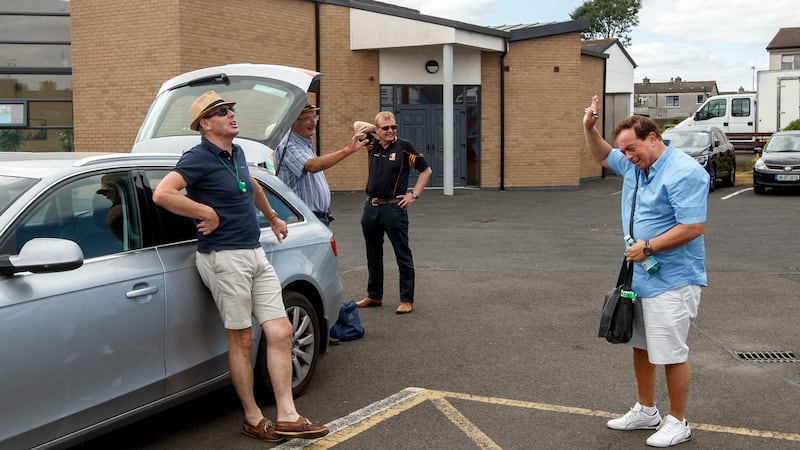
Marty was already running a bit late, though nobody seemed too concerned about this. “Marty could arrive at five to three and park on the pitch if he felt like it,” said one RTÉ staffer.
In fact, he parks in the car park of the church across from the stadium, near the RTÉ roadcaster from which his radio show will later be broadcast.
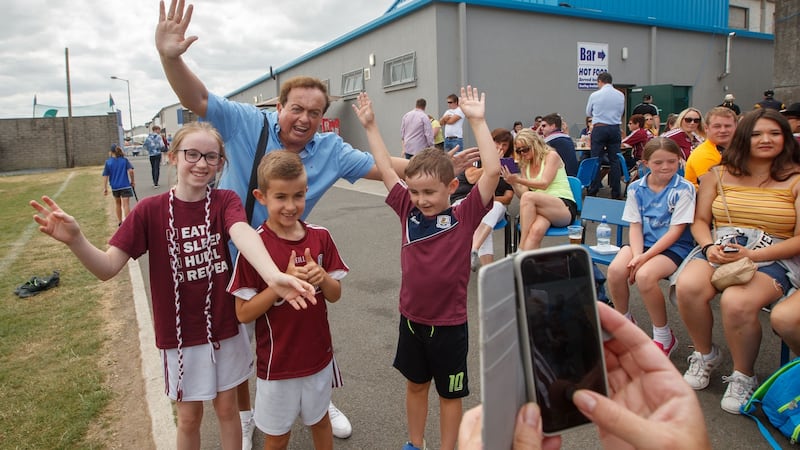
“When’s the game on?” Marty asks as he gets out of his car.
“Not for another hour-and-a-half, Marty,” says one of his radio show team.
“Sure, I’ll go away again and come back,” he says, pretending to get back into the car.
Marty is wearing a long blue and white shirt, white knee-length shorts and the whitest runners I have ever seen. He’s got a black leather bag hanging from his shoulder and a chunky Guess watch on his wrist. “It looks more expensive than it is,” he says.
“You broadcast wearing shorts?” I ask.
“They just shoot me from the waist up,” he says. “Normally I wear trousers.”
A little later at Doyle's Corner he orders five ice-cream cones and makes small talk with a man who he learns comes from Sixmilebridge in Marty's home county of Clare.
“I knew there was something good in you,” says Marty.
“That’s grand, Marty,” says the girl behind the till, refusing to take his money.
“Thank you,” says Marty, passing out the ice-creams to friends. “Tell your dad I was asking for him.”
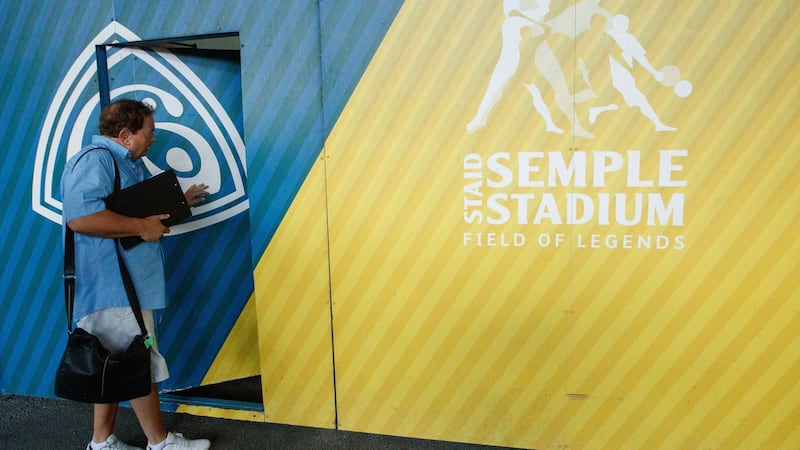
There is, I learn, a Marty Morrissey force field within which ice-creams are free and security guards don’t check press credentials (“The lads are with me,” Marty frequently says). Within this force field Marty makes people feel special. He distributes hugs, references regionally specific place-names and GAA players and, most crucially, he poses for photographs. You cannot walk 10 steps with Marty Morrissey without someone asking for one.
How many photos does he do a day? “I wouldn’t like to count to be honest with you,” says Marty. “But isn’t it nice to be asked?”
For each photo Marty grins widely and gives a thumbs-up or delivers an, “It’s yourself” pointing hand gesture. “Up Galway,” he says if the person is wearing a Galway shirt. “Up Kilkenny,” he says if they’re from Kilkenny.
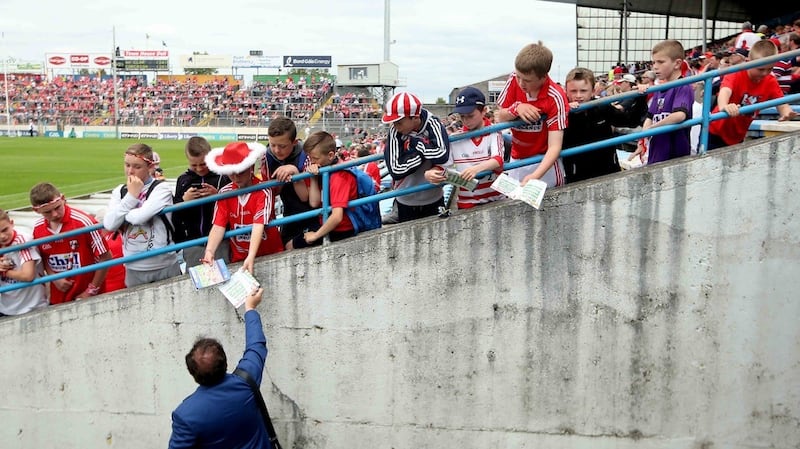
A lot more children have been asking for photos since he appeared on Dancing with the Stars. "It's mad," he says. "Shouldn't they be chasing One Direction or something?"
Most are giddy with excitement, although one shy little girl has to be coaxed by her iPhone-wielding mother. "Come on Louise," she says. "It's Marty, you loved him on Dancing with the Stars . . . I'll buy you an ice-cream."
“I can be bought for an ice-cream too,” says Marty.
He poses with a giant of a man who towers over him. “How tall are you?” asks Marty pretending to jump to get in shot.
We pass stalls selling hats and T-shirts and a challenge game where people have to puck a sliotar at life-sized pictures of celebrities for cash prizes. Morrissey points to his own image, a sliotar-shaped hole where its mouth should be. “I’m glad I’m the fifty quid option,” he shouts to the man at the stall. “Not the ‘free sliotar’.”
“You were got there last week,” says the man.
“Fair play to them,” says Marty.
He asks me about my own county background and I explain my ignorance of GAA. “This sport is called hurling, Patrick,” he says, as some boys with hurleys walk by. One, it turns out, already has Marty’s name written on his hurley. “We met you last week,” says his dad.
“So you did,” says Marty.
GAA
Marty knew very early on that the GAA was special, he says. He spent his early childhood in New York, where his Clare-born father and Corkonian mother moved when he was a baby (his father was in the travel business). "Every morning I would swear my allegiance to the American flag, hail, rain, sleet or snow, and then on Sundays I'd go to Gaelic Park and be diluted by the whole GAA culture," he says. "At the time it was a bit of an employment exchange. There were no mobile phones, no internet and people would meet and say, 'Your brother is coming over? Well, I think I've something for him.'... I felt at home in Gaelic Park."
Did he want to be a commentator in those days? He laughs. “As a kid in New York I wanted to be a bus driver,” he says. “I’d have a plate like this.” He mimes holding a plate like a steering wheel. “I’d drive around going ‘beep beep’ and taking in the money. I went from that to wanting to be a priest. I’d put a towel over my shoulder and say mass. A Marietta biscuit was the host. A few neighbours died unknown to themselves in my mass. I’d say prayers for them.”
Outside studio
Over at RTÉ’s Outside Broadcasting Unit, Marty shows me the notes he’s come over to share with the graphics team. “Is that Comic Sans?” I ask, referring to the font he has chosen.
“It is,” he says, with glee. “Well done. It’s my favourite font. Jesus, Patrick, nobody knows about Comic Sans. That’s a new one on me now . . . The other one I use is Arial. Not the washing up thing.”
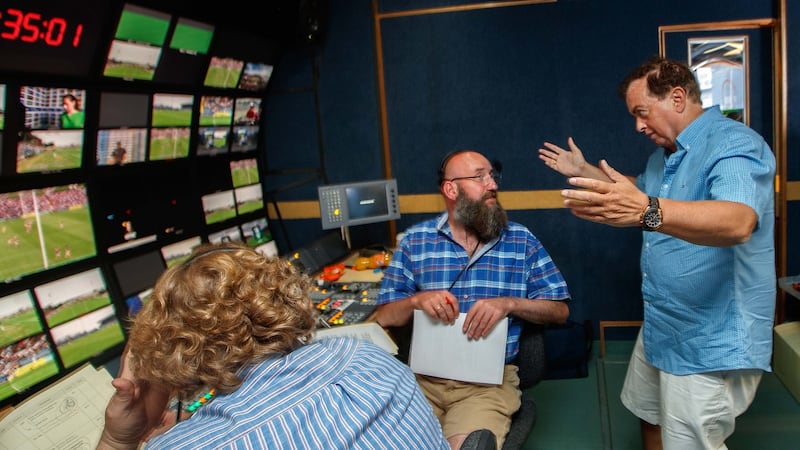
In the cool studio, Marty introduces me and the photographer to a team of people sitting before an array of screens. “That’s the love of my life,” he says, pointing to a graphics person.
"They're not from The Irish Times at all," says Wesley Liddy, the programme editor. "Marty paid them to follow him around."
Marty shakes his head. “The lack of respect in here.”
We head back to the radio roadcaster where Marty broadcasts a Facebook Live chat with two former hurlers, David Collins and Michael Kavanagh, whose analysis of team tactics I don't understand but whose mockery of Marty's shorts I do.
Move to Ireland
When he was 11, Marty's family moved back to the village of Quilty in Clare where his father bought a pub. "I missed city life in the sense that when I looked out from my bedroom all I could see every 13 seconds was the lighthouse on the Aran Islands," he says. "So going from the city lights of New York to that was a bit of a change . . . They were calling me 'the yank' in school."
Did he have an American accent? “I think I did, yeah. Then I started playing football and hurling at St Flannan’s. I often thought, when I left, ‘What would it have been like for a young boy who wasn’t a sports person?’ Being an only child and having no brothers and sisters, friends were very important to me. And all the friends I had as a child I still have, thankfully. I’m a Scorpio so loyalty would be important.”
Does he believe in horoscopes? He laughs. “I wouldn’t look at them every day, but I’d look at them.”
Girlfriends and loves
"Hello darling," calls Marianne Conway from one of the stalls as we enter the stadium.
“Do they still play hurling in Tipperary?” asks Marty to Marianne.
“Are you serious?” says Marianne. She turns to me. “He sent me a [fake] picture of Semple Stadium the other day and it had a sign saying, ‘Silage for sale’ and loads of bales of hay on it.”
“I sent that to her,” confirms Marty.
“I just sent back ‘f, dot, dot, k off,” she says.
“I’m here to interview him,” I say.
“Do you not know enough about him?” she asks.
“That’s my girlfriend, Marianne,” says Marty.
“This is the second ‘girlfriend’ or ‘love of your life’ I’ve met today,” I say.
“I think it is, yeah,” says Marty. “I’d want to cop onto myself.”
In the tunnel, Marty scouts his contacts to see if there have been any changes to the team line-ups and gets into a chat with Galway chief executive John Hynes. Hynes shows Marty a letter he sent to Fifa chairman Gianni Infantino suggesting that Fifa might consider pushing the final of the World Cup back a bit because it clashes with a Galway-Kerry match. It's addressed to "Uachtaran Fifa" and begins "Gianni, a chara."
Did he really send that? “I did,” says Hynes.
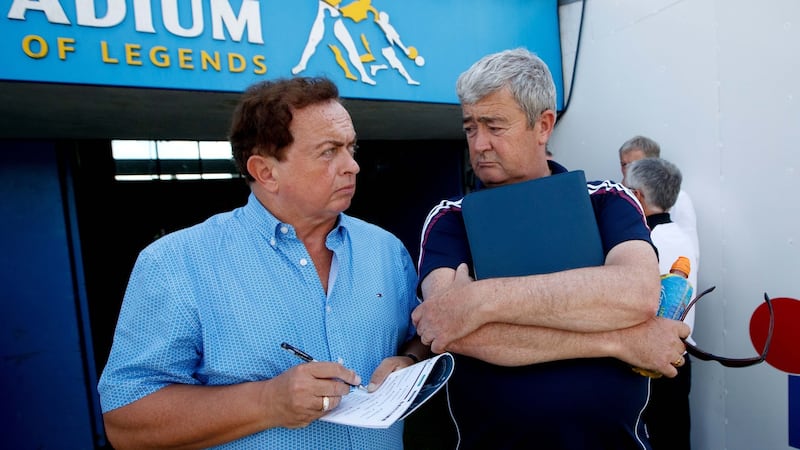
As we move through the stand towards the commentary box Marty stops for everyone who wants a photograph. At one point he introduces me to a man he says is his bank manager. “What did I tell you about not spending money on flashy shirts like that?” says Marty’s bank manager.
Match commentary
In 1984, Marty was teaching in Spanish Point (he'd been to UCC and had a HDip from NUIG) when Patrick Galvin from the Quilty post office asked him to do match commentary for a video he was making. He did so from the back of a tractor and trailer, shielded from the winds by some galvanised metal.
Overlooking the pitch at Semple Stadium there’s a row of commentary boxes for different TV and radio stations. When a match is on, it’s a corridor of Babel and I’ve no idea how anyone can concentrate.
In Marty's booth I meet his co-commentator, former Offaly hurler and coach Michael Duignan, and Marty's "stat man" of 15 years, former Limerick hurler David "Punchy" Punch.
Punchy’s job is to pass facts and figures to Marty. In front of him is a tiny pair of binoculars, a “bingo sheet” of stats and some pre-written sentences on pieces of paper with words to be filled in later. “Galway haven’t scored since the [blank space] minute”, reads one.
What happens if Punchy gets something wrong? “He can’t say anything because of the microphone,” says Punchy, “But he’s perfected the dirty look.”
Marty demonstrates the dirty look, and, for the record, I would not like to be on the receiving end of it. “Punchy is top notch in fairness,” he says.
Marty has pages of notes with him too. “But I only use 5 per cent of it,” he says.
“I just bring a pen,” says Duignan.
Then the game starts and headphones go on. Due to the clamour, I can’t recount what was said (you can go to the RTÉ player for that) but I can describe what they look like. Marty moves his hands a lot and shifts from foot to foot, occasionally fanning himself with a match programme. Michael stands relatively still, sporadically putting his hand on Marty’s back when he has something he wants to say. Punchy passes notes and mimes like a star from the silent era.
At half time, with Galway ahead, Marty laughs and shows Michael a tweet from someone in Chattanooga who delayed his wedding until after the match. "I played a county semi-final the day after my wedding," says Michael. "We won by a point."
In the second half Kilkenny make a valiant attempt at a comeback, but Galway win. “If you want drama, if you want a heart attack, then this is the match for you,” says Marty.
Love of the game
What makes someone a good commentator? “You have to have a love of the game,” says Marty. “You have to have passion. And you have to be honest and fair. You forget sometimes you’re broadcasting to the nation because you get so wrapped up in it.
Players, managers, the audience, they need to know you're on their side and you want them to be their best
You have to know the game and to know the players’ body shape. You can’t just rely on helmet colours and numbers. You can’t spoof it. I suppose it’s about connection and trust. If you don’t have trust, you don’t have anything. Players, managers, the audience, they need to know you’re on their side and you want them to be their best.”
Could he commentate on anything? Could he commentate on a man walking down the street? “I’d give it a lash,” he says.
Correspondent
In the sweltering heat we rush from the commentary box and onto the pitch where Marty must do his other job as GAA correspondent.
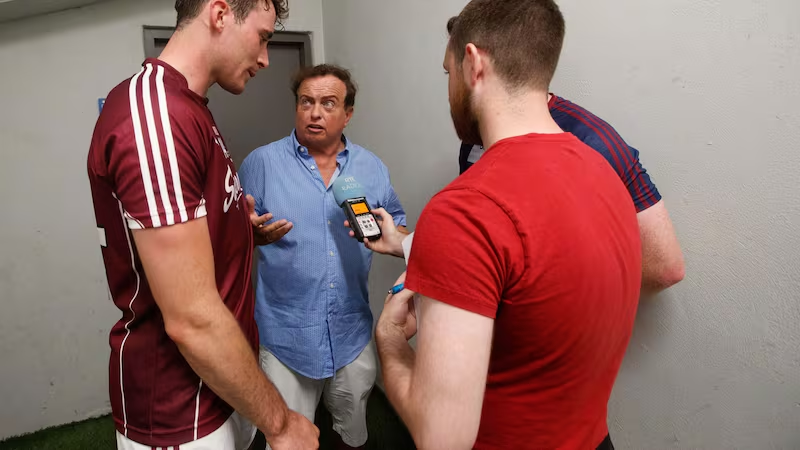
En route, he poses for pictures and signs a few hurleys. Eventually he reaches the other side of the field where he interviews Galway captain David Burke, then he heads back across the field in the other direction to interview more Galway players and a Kilkenny coach.
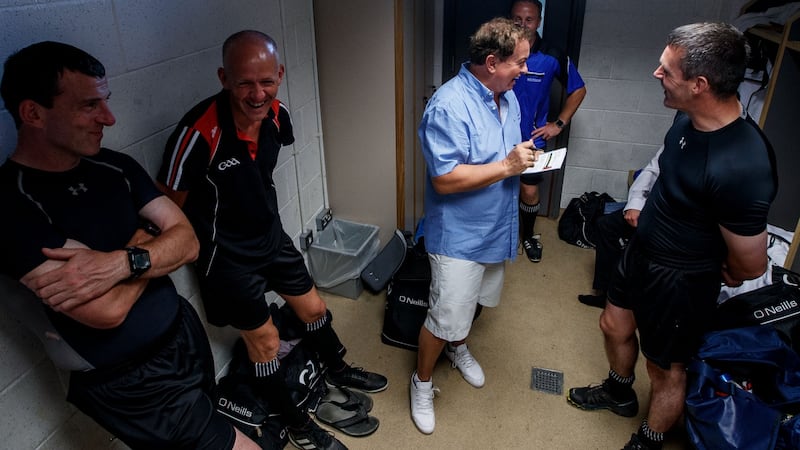
The pitch is like an obstacle course made up of big-eyed children with iPhones, none of whom Marty can resist stopping for. "Marty, can I dance with you?" asks one woman. Marty does a little waltz with her. It occurs to me that Marty might not be the most famous person in the world, but he's the most famous person in the world in Ireland.
National consciousness
Marty first jumped into the national consciousness after commentating at the Clare-Kerry Munster football final of 1992 (he had begun working for RTÉ in 1989 after working with Cork Multichannel). Inspired, he says, by the sight of young men he knew beating Kerry, he said something his neighbour used to say: "There won't be a cow milked in Clare tonight . . . I don't know why but it just came into my brain."
In 2013 when Clare got a late equalising point against Cork in the All Ireland final he found himself exclaiming “Holy Moses” and Twitter went wild. “I couldn’t think of anything else that wasn’t an expletive. I don’t know why I went biblical, but I did.”
After Marty became established as a boxing commentator in the noughties, Bernard Dunne asked him to introduce him at the Point. "That's when I started saying 'Are You Ready to Rock?'"
Now he's the kind of star who gets lampooned by satirists like Oliver Callan and Mario Rosenstock and there are fake twitter accounts and cartoons in his honour. Once, he says that he thought RTÉ was for "Dublin 4 types and not a culchie from the wilds of west Clare".
Accordingly, his ambition was simply to follow in the footsteps of his heroes, Michael O’Hehir and Mícheál O’Muircheartaigh, but now he wants to do more. He hosts the Ploughing Championships and Bloom and he has aspirations to present a regional variety show.
This year, appearing on Dancing with the Stars solidified his status as a celebrity. He still has the Marty Party chat group the cast set up and he considers them friends. He shows me his phone and even as we speak, messages from Erin McGregor, Anna Geary and Maia Dunphy pop up. "I loved Dancing with the Stars," he says. "And there's a part of me that misses it."
Fan interviews
Out by the roadcaster Marty is interviewing fans for his live Marty Squad radio show, his third job of the day.
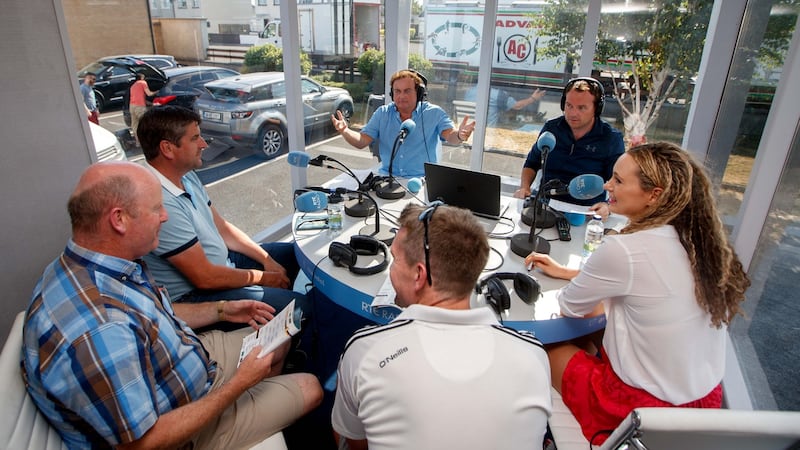
"He's been in RTÉ I don't know how long," says co-presenter Damian Lawlor. "But I think he's been a real overnight sensation in the past few years. I've seen players after winning games and the fans walk past them and walk straight to Marty."
His other co-presenter, Brenda Donohue, says: "Everyone loves him. At the Ploughing they have a little buggy to get them around on and it's like the pope mobile when Marty's on it. Sometimes I get quite frustrated because you might be coming up to show time and he's still there joking with somebody and I've had to reef him out."
She talks with some awe about Marty's kindness and ability to connect with people. I tell her about the free ice-creams. She laughs. "We were doing a match maybe two years ago. I was driving in here and could see Marty was a few cars in front of me and I rolled down the window to pay a fiver and the man said, 'I didn't charge Marty, so I won't charge you.' Then I went into Doyle's to grab a sandwich and the man said, 'I didn't charge Marty so I won't charge you.' They have lovely boutiques in Thurles and I was trying on a little slip and she said, 'I didn't charge Marty so I won't charge you.'" She laughs. "The last bit isn't true."
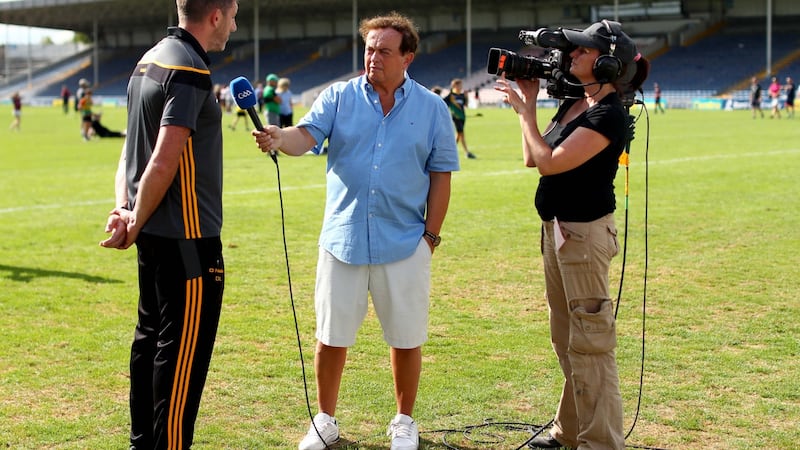
Does he have hobbies? “This is his hobby,” she says. “He loves having a meal afterwards and a catch-up and a chat.”
It’s a lot of work isn’t it? “I think so. I think it’s a lot. I’d love to see him do something a little more anchored.” She laughs. “That’s just me being a mammy.”
After hours
It’s after seven, the crowds are gone, the workday is over and Marty is sitting at a picnic table at Doyle’s Corner enjoying the sun. Even now we’re interrupted sporadically by fans and GAA officials. At one point his co-host, Damian Lawlor, goes by in a car. “I hope you figure out the riddle,” he says to me.
I love socialising. I love being out and about
Marty will drive from here to Quilty. He has lived for nearly 18 years in Rathfarnham but his father died 14 years ago so he spends a lot of time with his mother. He also has a long-term girlfriend, Liz Kidney, who lives in Cork. He tells me about meeting her in the 1990s, but he says he prefers to keep that side of his life private.
He thinks he might be a workaholic. “Work takes up an awful lot,” he says. “But I’ve a good circle of friends.” He doesn’t really drink, he says, but he would often be the last person in a pub. “I love socialising. I love being out and about.”
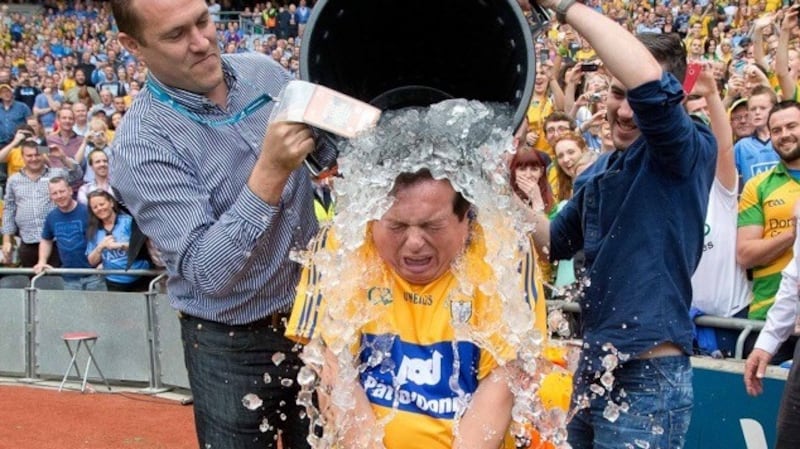
Does his love of community stem from the fact he comes from such a small family (both of his parents were also only children)? “I think that’s probably true. I wouldn’t deny it. We had the pub in Quilty and I was taken in by the locals as one of them and I feel a great sense of loyalty to the parish. I suppose my love of Gaelic games and community stems from that as well.”
Before heading on to Clare, Jimmy Doyle, the owner of Doyle's Corner, gives him another ice-cream. A little later, he asks if his daughter can have a photo with Marty. He takes the picture in front of the shop. "I knew there was a catch," chuckles Marty.
Marty still recalls his father taking the wireless out onto the fire escape of their fourth-floor Bronx apartment, then fiddling with the aerial so he could listen to Michael O'Hehir's commentary. "To this day, I'm very conscious of the emigrants and what this means to them," he says. "When my father heard Michael, suddenly he was transferred from a Bronx apartment to Croke Park. I realised then that this was something very important."








